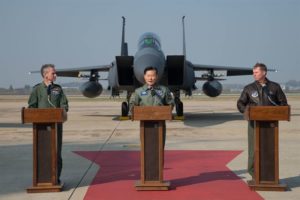Special to WorldTribune.com
 By Donald Kirk
By Donald Kirk
An air of unreality pervaded the atmosphere if not the skies over Osan Air Base this week as three of the niftiest warplanes on the planet zoomed off the runway for war games intended to strengthen their ability to work together to defeat a common foe.
Circumspectly, officers of the American, Korean and British Royal Air Force avoided identifying the foe, but their circumlocutions on that topic were mere technicalities.

As everyone knows, the pilots of the U.S. Air Force F16s, the Korean Air Force F15Ks and the RAF’s Typhoon Eurofighters had North Korea perfectly in their minds if not their sights as they staged make-believe dogfights against each other off the Korean west and east coasts. To them, and the generals who ordered them into the air, there was never a doubt as to whom they were training to shoot at.
On the ground, the image was far from clear — cloudy if not muddied. The best you might say, as Donald Trump shocked the soothsayers with his brand of nationalism and populism and President Park Geun-Hye struggled to keep her job if not her power, was that policy toward North Korea was in flux.
There was and is no coherent policy, solutions appear more elusive than ever, nobody knows what to think and no one’s in charge south of the demilitarized zone. (Above the DMZ, we assume Kim Jong-Un is firmly ensconced, though we can’t be sure of that either.)
All we know is that Trump has talked about South Korea and Japan obtaining their own nuclear weapons while the U.S. withdraws its troops from both countries. He’s also said China should put the screws to the North Koreans. Sounds good, but how far is he prepared to go in pressuring the Chinese — and how likely are the Chinese to cooperate while he’s threatening protective tariffs? At this stage, nobody knows.
As for President Park, you have to hope her defense, foreign and unification ministries are carrying on out of habit with no clear direction from above. In the battle for survival, how can she possibly keep up a policy toward North Korea that once seemed resolute. How can we be sure that she formulated that policy — or was in the thrall of a sisterly friend of four decades to whom she entrusted her speeches, along with state secrets, for review?
You would never suspect North Korean policy was in a mess, however, to judge from the performance of those sleek fighters as they flew in and out of Osan Air Base. The impression was that of stern resolve noteworthy for the British decision to send four Typhoons in war games described by their wing commander Roger Elliott as not only “spectacular” but “historic.”
Never since the Korean War had the Brits joined in war games in Korea until the arrival of the Typhoons — a sign, one might think, of allied determination to stand fast in the aftermath of North Korea’s fourth and fifth nuclear tests this year and a series of missile launches. Elliott’s protestations that British participation was “coincidental” with rising threats, was less than convincing, especially since Air Chief Marshal Sir Stephen Hillier, RAF chief of staff, was on hand reminding visitors of a relationship that “stretches back to the Korean War” in which more than 1,000 British troops were killed.
Lt. Gen. Thomas W. Bergeson, commander of the U.S. Seventh Air Force, left no doubt of the relationship between the role of the Typhoons and rising concerns about North Korea. “North Korea’s provocative action and threats to regional security,” he said, standing beside Hillier and South Korea’s Lt. Gen. Won In-Choul on the flight line, would only strengthen “our ironclad” commitment to South Korea.
But how much do such bold, non-compromising words mean as American and South Korean policy-makers wallow in disarray? Protests on the streets of Seoul, election celebrations in the U.S., seemed totally disconnected with anything these proud warriors were doing to hone their skills in waging war.
Everyone, every expert or political figure or concerned citizen, has a sure-fire solution to North Korea. Confusion reigns most dramatically on the streets of central Seoul where thousands of demonstrators are staging outbursts that seem to be growing in uncompromising intensity. It’s not clear, however, what the protesters, centrist or leftist, might suggest as a viable policy.
Nor is it clear what the experts in Washington are thinking. Yes, they all have proposals that they advance as gospel, irrefutable truth, but what’s going to come of this stew of ideas? The choices are not pleasant to contemplate.
“North Korea’s actions and rhetoric are also designed to make the United States’ choices as stark and difficult as possible,” writes Evans Revere, a former senior U.S. diplomat in Seoul, in a policy paper for the Brookings Institution in Washington. “Pyongyang hopes to leave the United States with no alternative but to deal with a nuclear-armed North Korea on its terms.”
The implications are not pretty. U.S., South Korean and British warplanes cut graceful circles far above the tumult while no one has a clue when the games will end – and the protagonists start shooting for real.
Donald Kirk has been covering war and peace in Northeast Asia for decades. He’s at [email protected].
